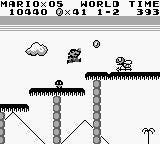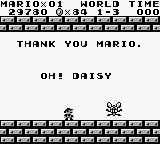Super Mario Land retrospective
Easton promises.
At the time of Super Mario Land's release, its producer, Gunpei Yokoi, was one of gaming's most influential figures. The man who invented the d-pad and mentored Shigeru Miyamoto - indeed, it was Yokoi who first brought Donkey Kong to then-president Hiroshi Yamauchi's attention - headed up an R&D1 team that could seemingly do no wrong. Responsible for the likes of Metroid and Kid Icarus, Nintendo's oldest internal studio was given the task of making a Mario game for Yokoi's latest innovation, a handheld device called the Game Boy.
Yet despite Yokoi's senior status, Super Mario Land feels like an act of rebellion. Study it closely and it increasingly feels tantamount to deliberate sabotage, or at the very least wilful subversion. Mario was not an R&D1 creation. He was Miyamoto's idea, not Yokoi's. And this experienced team did not consider their latest assignment a privilege. Not for nothing did Super Mario Land's sequel feature a villain named after a contraction of the Japanese word for 'evil' - warui - and Mario. Wario was a character born of frustration, a manifestation of his creators' ill feeling toward a character that wasn't theirs.

Yokoi's philosophy of lateral thinking with seasoned technology encouraged developers to embrace fun and novelty ahead of cutting-edge tech: it was a credo that worked wonders for Nintendo's Game and Watch devices and for the Game Boy itself. A by-product of the hardware's limitations was that familiar Mario elements needed a readjustment. Goombas and Koopas returned, albeit in miniscule form, barely recognisable from their NES sprites. 1-Ups defied tradition, too, appearing as hearts rather than mushrooms, although it could be argued that differentiating these tiny fungi from a standard super mushroom would have been difficult given their diminutive size and the Game Boy's four-colour display.
Yet if those constraints forced Yokoi's hand, other elements now seem more like an act of mutiny. Those tiny Goombas and Koopas would be fine in isolation, but they're dwarfed by the other enemies - sphinxes, skeletal fish, flying seahorses, robots and sentient Moai heads - making them seem petty and insignificant. Again, the inability to kick Koopas shells into other enemies can be dismissed as a natural side-effect of working with withered technology, but why do they explode? If Mario doesn't move quickly after stomping them, he'll take damage, or even die if he's not yet eaten a Super Mushroom. It's a cruel trick, an unexpected reversal of expectations, and a sign of an obstinate streak that runs through the whole game. Its disdain for the series' established ideas is all too apparent.
Even the elements that remain have a new twist - and perhaps the changes in terminology suggest Nintendo's own discomfort at such clear breaks from Mario tradition. Take the fire flower, for example, which here is referred to as the Superball Flower: rather than simply releasing bouncing fireballs to defeat enemies, its projectiles fly out at a 45-degree angle, ricocheting off scenery. They can even be used to collect distant coins, an idea Miyamoto himself would later revisit in Yoshi's Island, fittingly an act of defiance itself. Yokoi's former apprentice evidently learned more than game design from his master.

The most obvious departure from the plumber's earlier games, however, is the way Super Mario Land feels. Sure, we're not in the Mushroom Kingdom any more, which could explain a shift in the way Mario handles, but he's noticeably lighter, and his momentum is much easier to arrest, even at speed; you won't find yourself skidding off the edge of platforms any more. The lack of friction feels alien at first, as does the absence of that brief pause when collecting a Super Mushroom. Here, it's possible to get a power-up and lose it almost instantly.
Hieroglyphics, Easter Island heads, submarine shooting sections and those odd dragonfly creatures that inexplicably drop arrows: the more you play, the further it strays from the comforts of Marios past. The flagpole is gone, replaced by a different challenge - to reach the alternative exit at the top of the screen via collapsing platforms or bounce pads, instead of simply strolling through the lower door. Your reward is a bizarre little minigame where you hit the A button to stop Mario and a ladder cycling between platforms, sending the plumber sauntering across the screen (and climbing the steps if both land in the same place) to earn an extra life or three. You'll likely need them, too: with just 12 levels, Super Mario Land may be a short game, but the knowledge that game over means starting again from World 1-1 makes every lost life all the more painful.
It's hard to imagine a big publisher releasing a game like Super Mario Land these days; there's simply too much at stake to take such risks with a treasured brand. Perhaps that's why, 25 years later, it feels every bit as radical and distinctive as it was on its debut. History may remember its immediate predecessor as the better game, but by disregarding what had gone before, R&D1 established a game with a personality all its own; still bold enough to startle and provoke a quarter of a century on.









